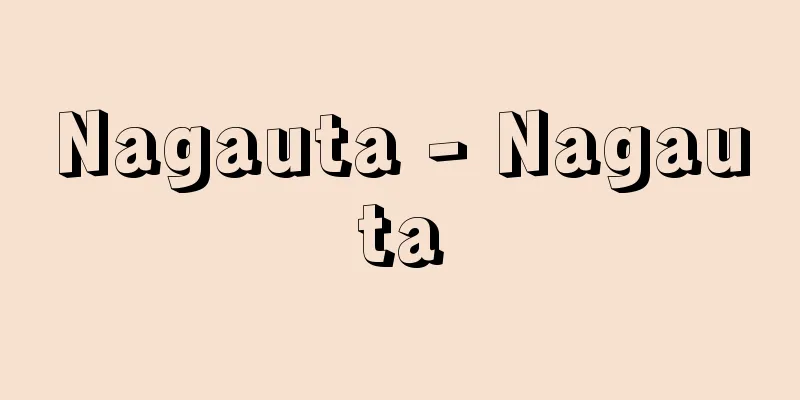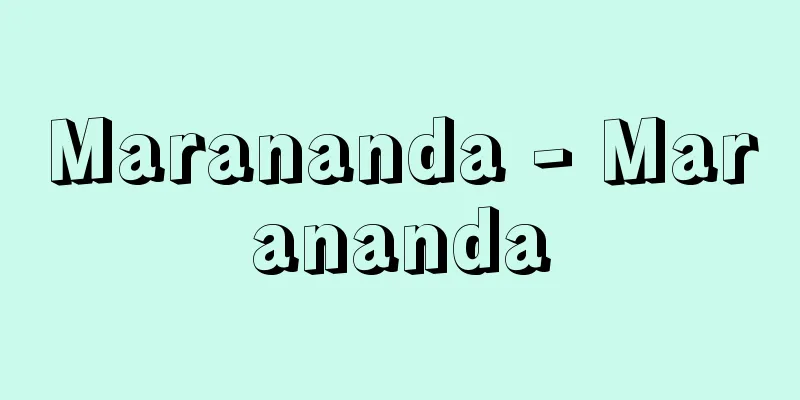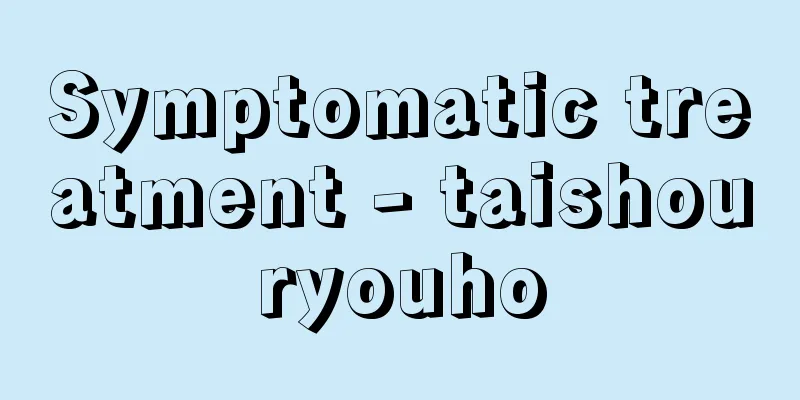Nagauta - Nagauta

|
A type of shamisen music. It was born as an accompaniment for Kabuki dance, and later Nagauta for appreciation (also called "Ozashiki Nagauta" or "Concert President's Song") also appeared. It is accompanied by the thin-necked shamisen and other musical instruments (Otsuzumi (large drum), Kotsuzumi (small drum), Fue (flute), Taiko drum, etc.). [Ueda Ryunosuke] nameThe name "nagauta" is said to have originated from the "chouta" (long song) in the jiuta (traditional folk songs) of Kamigata (the Kyoto-Osaka region), and then the long songs accompanied by shamisen in Kabuki plays came to be called "nagauta." It appeared around the Genroku period (1688-1704), and was originally written as "chouta," "choga," "nagauta," and so on. In the early days, it was differentiated into "Edo Nagauta," "Osaka Nagauta," and "Kyo Nagauta" depending on the place of origin of the performer, but as more and more performers came from Edo, the name "Edo" became meaningless, and it was often simply called "nagauta." [Ueda Ryunosuke] HistoryDuring the Genroku period, a relatively coherent Nagauta appeared among the shamisen music (jiuta) played by blind musicians in the Kamigata region. This became theatrical songs of the Kamigata region, and eventually spread to Edo when Kabuki actors from the Kamigata region made their way there. While influencing theatrical songs of Edo Kabuki, it was gradually weeded out by Edo tastes and developed into Edo Nagauta. Meanwhile, in Kamigata, although theatrical songs reached their peak during the Genroku period, they were not passed down as Kabuki music thereafter, and were absorbed into hauta, a type of jiuta music used in the Japanese courtyard, and Nagauta came to be limited to Edo Nagauta. [1] Kyoho to Horeki period (1716-1764): Due to the activities of Nagauta performers who traveled east with the Kabuki actors from the Kamigata region, the majority of songs were in the Sansagari style, heavily influenced by Jiuta. In addition, since Kabuki dance was the specialty of female actors at the time, there were many feminine songs. The singers included Sakata Hyosirou (1702-1749), the first Matsushima Shogoro, and the first Yoshizumi Kosaburo, the shamisen players included Kineya Kisaburo 6th (?-1730), Kineya Kisaburo 7th (?-1752), Kineya Shin'emon, and Kineya Yasaburo (?-1758), and the percussionists included Tada Itsuka and Uno Choshichi, and the songs produced included "Muken no Kane," "Aioi Jishi," "Kyoganoko Musume Dojoji," "Hanabusa Shujaku no Shishi," and "Sagi Musume." [2] The Meiwa Period (1764-1772) During this period, the first Fujita Kichiji (Yoshiharu), a singer with a beautiful voice, created a style of utajoruri that incorporated melodies from the Icchu-bushi, Bungo-bushi, Gidayu-bushi, and Geki-bushi styles, and became a sensation. He then moved into the pleasure quarters and created the Ogie-style Nagauta (later known as Ogie-bushi). The first generation of Ogie Royuu, who played the role of a master of the meriyasu, the first generation of Koide Ichijuro (?-1800), ... [3] The An'ei to Kansei period (1772-1801) was a transitional period for Nagauta, when it moved from the previous era of content-oriented Joruri singing to the heyday of the rhythmic Edo-style Nagauta of the Bunka and Bunsei periods. Singers included the first Kode Ichijuro, the first Matsunaga Chugoro (Matsunaga Wafu), the first Fujita Onzo, the first Yoshimura Isaburo (1719-1808), and the second Yoshimura Isaburo (1735-1821), while shamisen players included the eighth Kineya Kisaburo (?-1787), the second Rokusaburo, the first Shojiro, and the first Sakichi, who produced pieces such as "Nininwankyu," "Kumo Hyoshimai," "Godai Riki," and "Tokusakari." It was also during this period that the stage was adapted to feature a tiered platform (a platform on which performers sat, one above the other, and performed), making for more spectacular performances. [4] Bunka to Bunsei period (1804-1830): This was the golden age of Nagauta. With the popularity of Henge dance, many short dance pieces were composed, while the beauty of variation was displayed through interplay with Bungo-bushi style Joruri (Tokiwazu, Tomimoto, Kiyomoto). Pieces composed include "Echigojishi," "Shiokumi," "Shitadashisanbaso," "Tomoyakko," "Urashima," and "Kakubei." It was during this period that pieces such as "Oimatsu," "Gekizaru," and "Azuma Hakkei" were composed as Nagauta for appreciation (ozashiki nagauta) that broke away from the constraints of Kabuki dance. In 1826 (Bunsei 9), the Ozatsuma-bushi style, characterized by its dynamic rhythm, was absorbed, and the range of Nagauta was expanded by actively using its melodies. Singers such as Yoshimura Isaburo II, Ijuro II, and Fujita Senzo I (1757-1824) were active, as were shamisen players Kineya Rokuzaemon IX, Shojiro II, Rokusaburo IV, and Saburosuke IV (later Rokuzaemon 10), and percussionists such as Mochizuki Tazaemon IV. [5] The Tenpo to Keio period (1830-1868): This was the heyday following the previous era. Nagauta pieces for appreciation, such as "Akino Irokusa" (Autumn Colors) and "Shikino Yamamba" (Mountain Witch of the Four Seasons), were composed. In addition, in a revivalist trend, pieces based on Noh songs, such as "Kanjincho" (The Crane and the Turtle), "Kishu Dojoji" (Dojoji Temple in Kishu), and "Rashomon" (Rashomon) were composed. The Three Masters of the Tenpo Era included Okayasu Kiyohachi (later Okayasu Kisaburo 3rd, 1792-1871), Yoshimura Ijuro 3rd (later Yoshizumi Kosaburo 2nd), and Fujita Onzo 2nd. Shamisen players included Kineya Rokuzaemon 10th, Rokusaburo 4th, Saburosuke 5th (later Rokuzaemon 11th to Kangoro 3rd), and Kineya Katsusaburo 2nd. Musical instruments included Mochizuki Tazaemon 4th and 5th, Rokugo Shinzaburo 4th (?-1850), and Tanaka Denzaemon 6th. [6] After the Meiji Period In the first half of the Meiji Period (1868-1896), the singers Yoshimura Isaburo V, Ijuro V, and Matsushima Shogoro II were active, while the three great shamisen players were Kineya Kangoro III (former Rokuzaemon 11), Kineya Katsusaburo II, and Kineya Shojiro III. They left behind such masterpieces as "Tsunayakata," "Mochizuki," "Funabenkei," "Shojiro Renjishi," and "Genroku Hanami Odori." In 1902 (Meiji 35), the 4th generation Yoshizumi Kosaburo (later Jikyo) and the 3rd generation Kineya Rokushiro (later Kineya Jokan 2) founded the Nagauta Kenseikai, which separated Nagauta from Kabuki theatre and popularized and spread Nagauta to ordinary households in the form of concerts as pure music for appreciation. Inspired by this, the heyday of Nagauta recitals came in the Taisho era. One of these was the Nagauta Fuyoukai, founded by the 4th generation Kineya Sakichi in 1912 (Taisho 1). Sakichi explored the world of beauty that could be expressed only with the shamisen, and released many shamisen-led pieces, including "The Four Seasons of Sumida" and "Matsuri," further expanding the scope of Nagauta. In 1925 (Taisho 14), the Nagauta Association was formed, contributing to the improvement and development of the Nagauta world. In the world of Nagauta from the late Meiji period to the Taisho and Showa periods, singers included the 6th Yoshimura Ijuro, the 5th Fujita Onzo, the 4th Yoshizumi Kosaburo, and the 4th Matsunaga Wafu, shamisen players included the 12th and 13th Kineya Rokuzaemon, the 5th Kangoro, the 2nd Kioneya Jōkan, the 4th Kineya Katsutaro (1885-1966), the 3rd Eizo, and the 4th Sakichi, and percussionists included the 7th Mochizuki Tazaemon, the 10th Tanaka Denzaemon, and the 3rd Jumi. This group was made up of many talented people, including Tamatabei (1859-1921), and they recreated the golden age of Nagauta, producing such songs as "Nanko," "Gojo Bridge," "Shinkyoku Urashima," "Tamagawa," "Toba no Koizuka," "Kibun Daijin," and "Oshichi Kichisa." During the Second World War, state control was strengthened, and militaristic works were born in Nagauta, while obscene lyrics were revised. However, the Nagauta world changed greatly after the war. Although vocalists, shamisen players, and percussionists were all organized under the iemoto system, on the other hand, exchanges between schools became more frequent, and it became possible for artists to perform under their real names. In terms of composition, a movement also arose to go far beyond the traditional realm of Nagauta and create new Japanese music incorporating various techniques from the fields of not only Japanese music but also Western music. On the other hand, from the standpoint of respecting the classics, preservation, research, and study of Nagauta were promoted by organizations such as the National Research Institute for Cultural Properties (now the National Institute for Cultural Properties) and the Japan Broadcasting Corporation, or by volunteers. In February 1955 (Showa 30), the first wave of designations of Important Intangible Cultural Properties and certification of holders was made, with Yamada Shotaro, a Nagauta shamisen player, being selected as the holder (Living National Treasure). In April of the following year, singers Yoshizumi Kosaburo IV (later Jikyo) and Yoshimura Ijuro VII were also certified. However, many of these great masters passed away between the 1950s and 1960s. As of April 2003 (Heisei 15), the Nagauta-related people who have been certified as holders of Important Intangible Cultural Properties (Living National Treasures) are singers Kineya Kisaburo 15 (1923-), Miyata Tetsuo (1934-), and others. The eight members were: Tobaya Satonobu VI, Tobaya Satocho 7, shamisen players Kineya Gosaburo 3 (1918-2013) and Matsushima Jusaburo 3 (1920-2007), musician Mochizuki Bokusei 4 (1934-2007), flute player Fukuhara Hyakunosuke 6, also known as Takara Sanzaemon 4 (1922-2010), and Katada Kisaku 4 (1935-2020). [Ueda Ryunosuke] Features(1) Nagauta is the most diverse and wide-ranging of all Japanese music. In the course of its development, it has incorporated techniques, melodies, and themes from Noh plays, Kyogen, Jiuta, various Joruri plays, popular songs, and folk songs, and is a thin-spoken art that is literally a culmination of Japanese traditional music. (2) Songs with complex modulations and melodies. Early Nagauta were short pieces in the Niagari key, but from around the Kyoho era, San-sagari became the norm, and Hon-sagari was also adopted. Today, Nagauta is performed by combining Hon-sagari, Niagari, and San-sagari, with the addition of polyphonic Uwa-joshi, separate melody alternations, or improvised Tama . (3) It is a song with a variety of performance methods. The minimum unit of performance is a solo performance on two instruments (two shamisen players and one singer), but it can also be performed with dozens of instruments and dozens of instruments. In addition, except for some of the Meriyasu, solo performances, and Nagauta for appreciation (Ozashiki Nagauta), wind instruments (Noh flute, bamboo flute), percussion instruments (Otsuzumi, Kotsuzumi, Taiko), and even interplay with Joruri (Gitayu, Kiyomoto, Tokiwazu), the performance methods are diverse. (4) It is a song with the most refined content among shamisen music, and its expression is not the extreme expressions of joy, anger, sorrow, and happiness seen in other joruri. This is the result of repeated refinement, especially since the Meiji period. Therefore, it is accepted without resistance as healthy family music and as a piece for amateur performance. [Ueda Ryunosuke] Source: Shogakukan Encyclopedia Nipponica About Encyclopedia Nipponica Information | Legend |
|
三味線音楽の一種目。歌舞伎(かぶき)舞踊の伴奏音楽として誕生、のち鑑賞用長唄(「お座敷長唄」とも「演奏会長唄」ともいわれる)も現れる。細棹(ほそざお)の三味線や鳴物(大鼓(おおつづみ/おおかわ)、小鼓、笛、太鼓など)を伴奏楽器とする。 [植田隆之助] 名称「長唄」の名称は、上方(かみがた)(京坂地方)の地歌(じうた)のなかの長歌に由来するといわれ、ついで歌舞伎芝居の、三味線を伴奏とする長編の歌曲も「ながうた」というようになった。元禄(げんろく)期(1688~1704)ごろ現れ、最初は「長歌」「長哥」「長うた」などとも記されていた。初期には演奏者の出身地によって、「江戸長唄」「大坂長唄」「京長唄」などと区別されていたが、江戸出身者が多くなるにつれて、「江戸」の名称も無意味となり、単に「長唄」とよばれることが多くなった。 [植田隆之助] 沿革元禄期に上方の盲人音楽家の演奏する三味線音楽(地歌)のなかに比較的まとまった内容をもった長歌が現れた。これが上方の芝居唄となり、やがて上方の歌舞伎俳優の江戸進出によって江戸にも伝来し、江戸歌舞伎の芝居唄にも影響を与えながら、しだいに江戸趣味に淘汰(とうた)され、江戸長唄として発展していった。一方、上方では、芝居唄は元禄期にその頂点に達したものの、その後は歌舞伎音楽としての伝承は行われず、座敷音楽としての地歌の一分野である端歌(はうた)のなかに吸収され、長唄といえば江戸長唄に限られるようになった。 〔1〕享保(きょうほう)~宝暦(ほうれき)期(1716~1764) 上方の歌舞伎俳優とともに東下した長唄演奏家の活躍により、地歌の影響の強い三下(さんさが)り調子の曲が中心である。また当時は歌舞伎舞踊が女方(おんながた)の専門芸であったところから、女性的な曲が多かった。唄方に坂田兵四郎(ひょうしろう)(1702―1749)、初世松島庄五郎、初世吉住(よしずみ)小三郎、三味線方に6世杵屋(きねや)喜三郎(?―1730)、7世杵屋喜三郎(?―1752)、杵屋新右衛門(しんえもん)、杵屋弥三郎(やさぶろう)(?―1758)、鳴物に多田逸八、宇野長七らが輩出、曲では『無間の鐘(むけんのかね)』『相生獅子(あいおいじし)』『京鹿子娘道成寺(きょうがのこむすめどうじょうじ)』『英執着獅子(はなぶさしゅうじゃくのしし)』『鷺娘(さぎむすめ)』などが生まれた。 〔2〕明和(めいわ)期(1764~1772) この期になると、一中節(いっちゅうぶし)・豊後(ぶんご)節・義太夫(ぎだゆう)節・外記(げき)節などの旋律を加味した唄浄瑠璃(うたじょうるり)を創始して一世を風靡(ふうび)した美声の唄方初世富士田吉次(ふじたきちじ)(吉治)、遊里に進出して荻江(おぎえ)風長唄(後の荻江節)を創始した初世荻江露友(ろゆう)、めりやすを得意とした初世湖出(こいで)市十郎(?―1800)、三味線方に西川奥蔵(おくぞう)(?―1768)、錦屋惣治(にしきやそうじ)(?―1771)、初世杵屋作十郎(1728―1799)、2世杵屋六三郎、鳴物に宇野長七、3世田中伝左衛門らが輩出した。この時期には立役(たちやく)(男役)にも舞踊の名手が現れ、立役舞踊も上演されるようになった。それに伴って男性的な曲も作曲され、本調子が積極的に取り入れられ、江戸趣味的な長唄も生まれた。『娘七種(むすめななくさ)』『吉原雀(よしわらすずめ)』『隈取安宅松(くまどりあたかのまつ)』などが作曲されている。 〔3〕安永(あんえい)~寛政(かんせい)期(1772~1801) 長唄の過渡期で、前代の内容本位の唄浄瑠璃の時代から次の文化(ぶんか)・文政(ぶんせい)期のリズミカルな江戸趣味的な長唄の全盛期を迎える転換期であった。唄方では初世湖出市十郎、初世松永忠五郎(松永和風)、初世富士田音蔵、初世芳村(よしむら)伊三郎(1719―1808)、2世芳村伊三郎(1735―1821)、三味線方に8世杵屋喜三郎(?―1787)、2世六三郎、初世正次郎、初世佐吉らが活躍し、『二人椀久(ににんわんきゅう)』『蜘蛛拍子舞(くものひょうしまい)』『五大力(ごだいりき)』『木賊刈(とくさかり)』などが生まれた。また舞台に雛壇(ひなだん)(演奏者が上下2段に座して演奏するための台)が採用されて華やかに演奏されるようになったのもこの時期からである。 〔4〕文化~文政期(1804~1830) 長唄の黄金時代。変化(へんげ)舞踊の流行に伴い短編の舞踊曲が数多く作曲され、一方では豊後(ぶんご)節系浄瑠璃(常磐津(ときわず)、富本(とみもと)、清元(きよもと))との掛合(かけあい)(一曲を細かく分担して交互に演奏する形式)による変化の妙が発揮された。『越後獅子(えちごじし)』『汐汲(しおくみ)』『舌出三番叟(しただしさんばそう)』『供奴(ともやっこ)』『浦島(うらしま)』『角兵衛(かくべえ)』などが作曲されている。また新たに歌舞伎舞踊の制約を脱した鑑賞用長唄(お座敷長唄)として『老松(おいまつ)』『外記猿(げきざる)』『吾妻八景(あづまはっけい)』などが作曲されたのもこの時期である。1826年(文政9)には豪快な節回しを持色とする大薩摩(おおざつま)節を吸収し、その後は積極的にその旋律を駆使し、長唄の領域は拡大された。唄方に2世芳村伊三郎、2世伊十郎、初世富士田千蔵(1757―1824)、三味線方に9代目杵屋六左衛門、2世正次郎、4世六三郎、4世三郎助(のち10代目六左衛門)、鳴物では4世望月(もちづき)太左衛門らが活躍している。 〔5〕天保(てんぽう)~慶応(けいおう)期(1830~1868) 前代に続く全盛期で、『秋色種(あきのいろくさ)』『四季の山姥(しきのやまんば)』など鑑賞用の長唄が作曲されるとともに、復古的な傾向として謡曲に題材を求めた『勧進帳(かんじんちょう)』『鶴亀(つるかめ)』『紀州道成寺』『羅生門(らしょうもん)』などが作曲された。唄方には天保の三名人といわれる岡安喜代八(おかやすきよはち)(のち3世岡安喜三郎。1792―1871)、3世芳村伊十郎(のち2世吉住小三郎)、2世富士田音蔵、三味線方では10代目杵屋六左衛門、4世六三郎、5世三郎助(のち11代目六左衛門から3世勘五郎)、2世杵屋勝三郎、鳴物では4世、5世望月太左衛門、4世六郷新三郎(ろくごうしんざぶろう)(?―1850)、6世田中伝左衛門らが輩出した。 〔6〕明治以降 明治前期(1868~1896)には唄方では5世芳村伊三郎、5世伊十郎、2世松島庄五郎が活躍し、三味線方では3世杵屋勘五郎(前11代目六左衛門)、2世杵屋勝三郎、3世杵屋正次郎が作曲の三傑として、『綱館(つなやかた)』『望月(もちづき)』『船弁慶(ふなべんけい)』『正治郎連獅子(れんじし)』『元禄花見踊(げんろくはなみおどり)』などの傑作を残している。1902年(明治35)、4世吉住小三郎(のち慈恭(じきょう))と3世杵屋六四郎(のち2世稀音家浄観(きねやじょうかん))によって長唄研精(けんせい)会が創設され、長唄を歌舞伎劇から独立させ、純粋な鑑賞用音楽として演奏会形式によって広く一般家庭へ普及、浸透させた。これに刺激されて、大正時代には演奏会長唄の全盛期を迎えた。1912年(大正1)に4世杵屋佐吉によって創設された長唄芙蓉(ふよう)会もその一つである。佐吉は三味線だけで表現できる美の世界を探究し、『隅田(すみだ)の四季』『まつり』をはじめ多くの三味線主奏楽を発表し、長唄の領域はさらに拡大された。1925年(大正14)には長唄協会が結成され、長唄界の向上発展のために貢献した。明治後期から大正・昭和期の長唄界には、唄方に6世芳村伊十郎、5世富士田音蔵、4世吉住小三郎、4世松永和風、三味線方に12代目・13代目杵屋六左衛門、5世勘五郎、2世稀音家浄観、4世杵屋勝太郎(1885―1966)、3世栄蔵、4世佐吉、鳴物に7世望月太左衛門、10世田中伝左衛門、3世住田又兵衛(1859―1921)とまさに多士済々、長唄の黄金時代を再現させ、『楠公(なんこう)』『五条橋(ごじょうばし)』『新曲浦島(しんきょくうらしま)』『多摩川(たまがわ)』『鳥羽の恋塚(とばのこいづか)』『紀文大尽(きぶんだいじん)』『お七吉三(おしちきちさ)』などの曲が生まれた。 第二次世界大戦中は国家の統制が強化され、長唄にも軍国主義的な作品が生まれるとともに、従来の卑猥(ひわい)な歌詞の改訂などが行われた。しかし、戦後の長唄界は大きく変貌(へんぼう)した。唄、三味線、鳴物ともに家元制度のもとに組織されてはいるものの、他方では各流派間の交流も盛んになり、本名で活躍することも可能となった。作曲面でも、従来の長唄の領域をはるかに越えて、邦楽はもちろん、洋楽の分野に至るさまざまな技法を取り入れた新しい日本音楽を創造しようという運動もおこった。しかし一方では、古典尊重の立場からその保存、調査研究が国立文化財研究所(現、文化財研究所)、日本放送協会などの団体、あるいは有志によって進められた。 1955年(昭和30)2月、第一次の重要無形文化財の指定と保持者の認定に際し、まず長唄三味線方の山田抄太郎(しょうたろう)が同保持者(人間国宝)に選ばれたのを皮切りに、翌年4月には唄方の4世吉住小三郎(のち慈恭(じきょう))、7世芳村伊十郎が認定された。しかし、昭和30年代から50年代にかけてこれら数多くの名人も没した。2003年(平成15)4月時点で重要無形文化財保持者(人間国宝)の認定を受けている長唄関係者は、唄方で15世杵屋喜三郎(1923― )、宮田哲男(てつお)(1934― )、7世鳥羽屋里長(とばやりちょう)、三味線方の3世杵屋五三郎(ごさぶろう)(1918―2013)、松島寿三郎(じゅさぶろう)(1920―2007)、囃子方(はやしかた)の4世望月朴清(ぼくせい)(1934―2007)、笛方の6世福原百之助(ひゃくのすけ)こと、4世宝山左衛門(たからさんざえもん)(1922―2010)、堅田喜三久(かただきさく)(1935―2020)の8名であった。 [植田隆之助] 特色(1)邦楽のなかでもっとも多様性に富んだ領域の広い歌曲である。長唄はその発展過程において、謡曲、狂言、地歌、各種浄瑠璃、流行唄(はやりうた)、民謡などの技法、曲節、あるいは題材を取り入れた、文字どおり日本の伝統音楽を集大成した細棹(ほそざお)芸術である。 (2)複雑な転調、旋律をもつ歌曲である。初期の長唄は二上(にあが)り調子の短編であったが、享保ごろより三下りが中心となり、さらに本調子も採用され、現在では本調子、二上り、三下りなどを組み合わせ、さらに複旋律の上調子(うわぢょうし)、別個の旋律の替手(かえで)、あるいは即興的なたまなどを加えて演奏する。 (3)多様な演奏法をもつ歌曲である。その演奏は二挺(にちょう)一枚(三味線方2名、唄方1名)の独吟を最小単位とし、数十挺数十枚で演奏することも可能であり、また、めりやす、独吟物、あるいは鑑賞用長唄(お座敷長唄)の一部を除き、管楽器(能管(のうかん)、竹笛)、打楽器(大鼓、小鼓、太鼓)も加えられ、さらに、浄瑠璃(義太夫節、清元節、常磐津節)との掛合も行うなど、演奏法が多様である。 (4)三味線音楽のなかでもっとも上品な内容をもつ歌曲であり、表現方法もほかの浄瑠璃にみられるような極端な喜怒哀楽の表現ではない。これはとくに明治以降洗練を重ねてきた結果である。したがって、健全な家庭音楽としても、また素人(しろうと)の演奏曲としても抵抗なく受け入れられている。 [植田隆之助] 出典 小学館 日本大百科全書(ニッポニカ)日本大百科全書(ニッポニカ)について 情報 | 凡例 |
<<: Nagauuni (long sea urchin) - Nagauuni (English spelling) Echinometra mathaei
Recommend
Calcio - Calcio
It refers to soccer (football). Source: About Shog...
Kenilworth
A town in the Warwick district of Warwickshire, ce...
Annales School
The Annales School (French: L'école des Annal...
Orpheon (English spelling)
…Amateur choirs were born, and many easy-to-under...
Flavor's degree of freedom
Also simply called flavor. A concept introduced to...
Antonioni, M.
... The founders of Neorealism are said to be the...
Horse-riding people theory
This theory posits that the founders of the unifie...
Moszkowski, A.
…German pianist and composer of Polish origin. He...
X-ray flash photography
...This method produces bright images with a rela...
Azumaichige - Azumaichige
It is a perennial plant of the Ranunculaceae (APG...
toadflax
...Although it is originally a northern plant, it...
al-Manzala, Buḥayra (English spelling) alManzala Buhayra
…A city in the Nile Delta in northern Egypt. Also...
Ion implantation
The process of ionizing gaseous atoms, acceleratin...
Sparaxis bulbifera (English spelling)
…[Tora Saburo Kawabata]. … *Some of the terminolo...
Khaidu - Haidu (English spelling)
A nomadic hero who conquered Central Asia during ...

![Saga [town] - Saga](/upload/images/67cba74dd9e85.webp)







